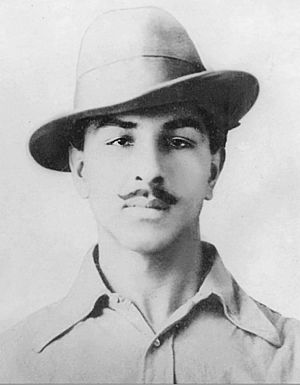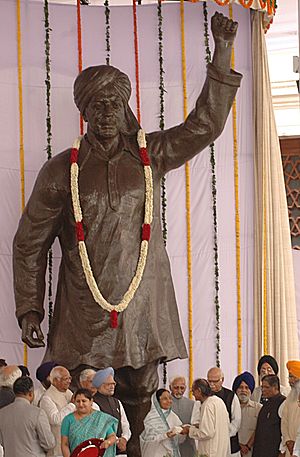Bhagat Singh facts for kids
Quick facts for kids
Bhagat Singh
|
|
|---|---|

Singh in 1929
|
|
| Born | 27 September 1907 Banga, Lyallpur District, Punjab Province, British India
(present-day Faisalabad District, Punjab, Pakistan) |
| Died | 23 March 1931 (aged 23) Lahore Central Jail, Lahore, Punjab Province, British India
(present-day Lahore District, Punjab, Pakistan) |
| Cause of death | Execution by hanging |
| Monuments | Hussainiwala National Martyrs Memorial |
| Other names | Shaheed-e-Azam |
| Organization | Naujawan Bharat Sabha Hindustan Socialist Republican Association |
|
Notable work
|
Why I Am an Atheist |
| Movement | Indian independence movement |
| Criminal charge(s) | Murder of John P. Saunders and Channan Singh |
| Criminal penalty | Capital punishment |
| Criminal status | Executed |
| Parents |
|
Bhagat Singh (born 27 September 1907 – died 23 March 1931) was a brave Indian revolutionary. He played a key role in India's fight for freedom from British rule. Many people saw him as a hero and a symbol of courage. He inspired young people across India to join the independence movement.
In December 1928, Bhagat Singh and his friend Shivaram Rajguru were part of a group called the Hindustan Socialist Republican Association. They wanted to get revenge for the death of a popular Indian leader, Lala Lajpat Rai. Rai had been hurt during a protest ordered by a British police officer, James Scott, and later died. Singh and Rajguru mistakenly targeted another British police officer, John Saunders, in Lahore. As Saunders left a police station, he was shot. Another friend, Chandra Shekhar Azad, also shot an Indian police officer who tried to chase them.
After this event, Bhagat Singh and his friends went into hiding. They put up posters saying they had avenged Lajpat Rai's death. Singh was on the run for many months. In April 1929, he appeared again with another friend, Batukeshwar Dutt. They threw two small, homemade bombs in the Central Legislative Assembly in Old Delhi. These bombs were not meant to hurt anyone. They were a protest to make a statement. They also threw leaflets and shouted slogans. Then, they allowed the authorities to arrest them. This arrest made people realize Singh's connection to the earlier incident. While waiting for his trial, Singh went on a hunger strike in jail. He demanded better conditions for Indian prisoners. Another prisoner, Jatin Das, also joined the strike and sadly died from starvation. This gained a lot of public sympathy for Singh.
Bhagat Singh was found guilty by the British government for his actions. He was executed in March 1931, when he was just 23 years old. After his death, he became a very popular folk hero. Jawaharlal Nehru, who later became India's first Prime Minister, said that Bhagat Singh became popular because he stood up for the honor of Lala Lajpat Rai and the nation. He became a powerful symbol of resistance. Bhagat Singh was an atheist (someone who doesn't believe in God) and a socialist (someone who believes in a society where everyone is equal). He is often called Shaheed-e-Azam, which means "Great Martyr" in Urdu and Punjabi.
Contents
Bhagat Singh's Popularity
Bhagat Singh became a symbol of new hope for young people. Subhas Chandra Bose, another important freedom fighter, said that Singh represented a new awakening among the youth. Jawaharlal Nehru noted that Singh's popularity was creating a new national spirit. He described Singh as a "clean fighter" who faced his enemies openly. Nehru said Singh was like a spark that quickly turned into a flame, spreading across the country and removing darkness. Four years after Singh's execution, a British official wrote that Singh's photograph was sold everywhere. It was almost as popular as Mahatma Gandhi's picture.
Remembering Bhagat Singh

Bhagat Singh is still a very important figure in India today. His memory is honored in many ways.
- On 15 August 2008, a large bronze statue of Singh was placed in the Parliament of India. It stands next to statues of other great leaders like Indira Gandhi and Subhas Chandra Bose. A picture of Singh and Dutt is also on the walls of the Parliament House.
- The place where Singh was cremated is Hussainiwala. This area became part of Pakistan after India's partition. In 1961, it was given back to India. The Hussainiwala National Martyrs Memorial was built there in 1968. It honors Singh, Rajguru, and Sukhdev.
- The Shaheedi Mela (Martyrdom Fair) is held every year on 23 March. People visit the National Martyrs Memorial to pay their respects. This day is also celebrated across the Indian state of Punjab.
- The Shaheed-e-Azam Sardar Bhagat Singh Museum opened in his ancestral village, Khatkar Kalan. It displays many of his personal items. These include his ashes, blood-stained sand, and a copy of the Bhagavad Gita he read in jail.
- The Supreme Court of India has a museum that shows important moments in India's legal history. The first exhibition was about the Trial of Bhagat Singh. It opened on 28 September 2007, for his 100th birthday.
Bhagat Singh in Modern Times
Young people in India continue to find great inspiration from Bhagat Singh. In a 2008 poll by India Today magazine, he was voted the "Greatest Indian." He was chosen over other famous figures like Bose and Gandhi. On his 100th birthday, a group of thinkers started an organization to remember him and his ideas. The Parliament of India has also paid tribute to Singh on 23 March in 2001 and 2005. In Pakistan, activists asked for Shadman Chowk square in Lahore to be renamed Bhagat Singh Chowk. This is where he was executed.
Films and Television Shows
Many films and TV shows have been made about Bhagat Singh's life.
- The first film about him was Shaheed-e-Azad Bhagat Singh (1954).
- Later films include Shaheed Bhagat Singh (1963) starring Shammi Kapoor, and Shaheed (1965) with Manoj Kumar.
- In 2002, three films about Singh were released: Shaheed-E-Azam, 23 March 1931: Shaheed, and The Legend of Bhagat Singh.
- The TV drama Bhagat Singh (2002) was shown on DD National.
- Siddharth played Bhagat Singh in the 2006 film Rang De Basanti. This movie compared revolutionaries from Singh's time to modern Indian youth.
- Karam Rajpal played Bhagat Singh in the TV series Chandrashekhar.
- In 2008, a 40-minute documentary called Inqilab was made about Bhagat Singh.
Theatre and Songs
Bhagat Singh, Sukhdev, and Rajguru have inspired many plays in India and Pakistan. These plays continue to be very popular. Two patriotic songs are strongly linked with Bhagat Singh. They are "Sarfaroshi Ki Tamanna" ("The desire to sacrifice") and "Mera Rang De Basanti Chola" ("O Mother! Dye my robe the color of spring"). These songs have been used in many films about him.
Other Tributes
In 1968, India issued a postage stamp to honor Bhagat Singh's 61st birthday. In 2012, a special ₹5 coin was released with his image.
Books by Bhagat Singh
Bhagat Singh also wrote books and articles during his life. Some of his notable works include:
- Why I Am an Atheist (1931)
- Jail Diary and Other Writings (2019)
- Ideas of a Nation: Singh, Bhagat (2010)
- No Hanging, Please Shoot Us (2019)
- Letter to my Father (2019)
Images for kids





